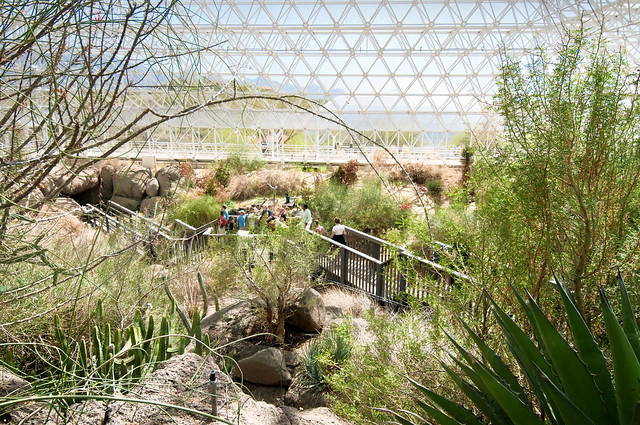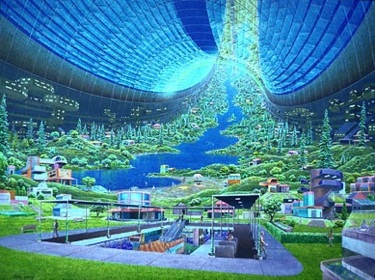As more and more (and more) groups announce their intent to venture to Mars, it’s perhaps inevitable that we’d see some fairly odd life-sustaining science developing; and now Chinese state media is reporting that their nation’s space program has developed the ability to grow vegetables on the red planet! The technique tested here on earth, in Beijing would enable astronauts on China’s planned missions to the moon and to Mars to not only grow vegetables, but also to maintain an “ecological life support system” that would also produce air and water.
Scientists at the Chinese Astronaut Research and Training Center created the plant- and algae-based “ecological life support system,” a 300 cubic meter cabin, so that “Chinese astronauts may get fresh vegetables and oxygen supplies by gardening in extra-terrestrial bases in the future,” according to a report from the Xinhua news agency. Such missions are likely to include China’s efforts to send a manned mission to the moon, following a planned unmanned moon landing.
When researchers sent plants to the International Space Station in 2010, the flora called Arabidopsis thaliana were the subject of an experiment to study how plant roots developed in a weightless environment.
Gravity is an important influence on root growth, but the scientists found that their space plants didn't need it to flourish. The research team from the University of Florida in Gainesville thinks this ability is related to a plant's inherent ability to orient itself as it grows. Seeds germinated on the International Space Station sprouted roots that behaved like they would on Earth growing away from the seed to seek nutrients and water in exactly the same pattern observed with gravity.
The flowers were orbiting some 220 miles (350 kilometers) above the Earth at the time, the NASA-funded experiment suggests that plants still retain an earthy instinct when they don't have gravity as a guide. The finding further boosts the prospect of cultivating food plants in space and, eventually, on other planets.
Previously, Biosphere 2 was an Earth systems science research facility currently owned by the University of Arizona since 2011. It also explored the possible use of closed biospheres in space colonization, and allowed the study and manipulation of a biosphere without harming Earth's. The name comes from Earth's biosphere, Biosphere 1. Earth's life system is the only biosphere currently known. Funding for the project came primarily from the joint venture's financial partner, Ed Bass' Decisions Investment, and cost $200 million from 1985 to 2007, including land, support research greenhouses, test module and staff facilities.
With a size comparable to two and a half football fields, it remains the largest closed system ever created. The glass facility is elevated nearly 4,000 feet (1300 m) above sea level at the base of the Santa Catalina Mountains, about a half hour outside of Tucson.
Biosphere 2 contained representative biomes: a 1,900 square meter rainforest, an 850 square meter ocean with a coral reef, a 450 square meter mangrove wetlands, a 1,300 square meter savannah grassland, a 1,400 square meter fog desert, a 2,500 square meter agricultural system, a human habitat, and a below-ground level technical infrastructure. Heating and cooling water circulated through independent piping systems and passive solar input through the glass space frame panels covering most of the facility, and electrical power was supplied into Biosphere 2 from an onsite natural gas energy center through airtight penetrations.
Among the problems and miscalculations encountered in the first mission were overstocked fish clogging systems, unanticipated condensation making the "desert" too wet, population explosions of greenhouse ants and cockroaches, and morning glories overgrowing the "rainforest", blocking out other plants.
There was further controversy when the public learned that the project had allowed an injured member to leave and return, carrying new material inside. The team claimed the only new supplies brought in were plastic bags, but others accused them of bringing food and other items. More outrage was raised when it was learned that, likewise, the project had been pumping oxygen inside, to make up for a failure in the balance of the system that resulted in the amount of oxygen steadily declining.
 The oxygen inside the facility, which began at 20.9%, fell at a steady pace and after 16 months was down to 14.5%. This is equivalent to the oxygen availability at an elevation of 4,080 meters (13,400 ft). Since some biospherians were starting to have symptoms like sleep apnea and fatigue, Walford and the medical team decided to boost oxygen with injections in January and August 1993.
The oxygen inside the facility, which began at 20.9%, fell at a steady pace and after 16 months was down to 14.5%. This is equivalent to the oxygen availability at an elevation of 4,080 meters (13,400 ft). Since some biospherians were starting to have symptoms like sleep apnea and fatigue, Walford and the medical team decided to boost oxygen with injections in January and August 1993.
A vast majority of Biosphere II was built out of concrete, which contains calcium hydroxide. Instead of being consumed by the plants to produce more oxygen, the excess carbon dioxide was reacting with calcium hydroxide in the concrete walls to form calcium carbonate and water.
Ca(OH)2 + CO2 -- CaCO3 + H2O
This hypothesis was confirmed when scientists tested the walls and found that they contained about ten times the amount of calcium carbonate on the inner surfaces as they did on the outer surfaces. All of the walls in Biosphere II are now coated with a protective layer, but oxygen levels continue to be somewhat problematic.
Though much of the research conducted by NASA and other space agencies is important to the space programs, the impact of space farming has many real-life applications for Earth. The main benefit and purpose of learning how to farm in space is to enable long-term space exploration it's critical that astronauts have a regenerative food source.
 Researchers hope to transfer what they learn about growing food in the inhospitable climate of space to equally challenging and hostile climates on Earth. They are collecting detailed information about how plants grow and hope this information will help as land becomes scarcer and less fertile. Goals include higher quality crops, higher crop yields and better controlled agricultural systems and greenhouses.
Researchers hope to transfer what they learn about growing food in the inhospitable climate of space to equally challenging and hostile climates on Earth. They are collecting detailed information about how plants grow and hope this information will help as land becomes scarcer and less fertile. Goals include higher quality crops, higher crop yields and better controlled agricultural systems and greenhouses.
Space farming has led to some other surprising and useful applications here on Earth. One is a special device called Bio-KES which converts ethylene into carbon dioxide and water using ultraviolet light. Ethylene causes plants to ripen and eventually spoil. A device like Bio-KES, used in food storage units and display cases, could help increase the shelf life of produce, flowers and other perishable items. Ultraviolet light has other applications besides helping to reduce the amount of rotten food we must discard. It can also be used to kill pathogens like anthrax, help wounds heal faster and improve the effectiveness of some cancer treatments.
There’s the cultural legacy, a general awareness of Earth itself as a largely-closed system that can be easily and unpredictably perturbed. The venture into space may need to adopt a holistic approach when farming food supplies. Maintaining oxygen levels and recycling programs maybe part of the important factors for space or planet farming. From psychological studies of scientists overwintering in Antarctic research stations. The study of this phenomenon is "confined environment psychology", and according to Jane Poynter (a Biosphere resident researcher) not nearly enough of it was brought to bear on Biosphere 2. Intimate friends had become enemies, that were barely on speaking terms. Potential conflict had been pointed to as a possibility since this was the first experiment ever in closed, confined, system, over such a "long" period of time.
The end result that space farming might be a test on ones character, as well as endurance and discipline. The lessons learned from Biosphere two could prove important as the possibility of living away from the earth slowly becomes a reality. As space tourism, military bases, manufacturing plants and other avenues of a zero gravity environment become a reality. The need for food and air will be a growing industry too...







No comments:
Post a Comment